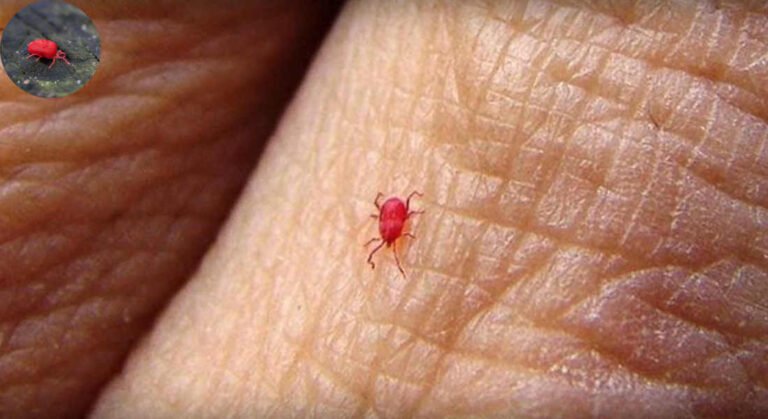Chiggers, also known as red bugs or harvest mites, are primarily outdoor pests that thrive in damp, grassy, and wooded environments. While they are most commonly found in yards and fields, there are situations where chiggers can make their way into homes—often hitching a ride on pets, clothing, or even through open windows and doors. Unlike fleas or bed bugs, chiggers do not establish long-term infestations inside homes, as they require a host to survive and cannot thrive for more than a few days indoors. Nevertheless, their presence can cause itchy, uncomfortable bites, making it important to understand how they enter homes and what steps can be taken to prevent and eliminate them.
What are Chiggers and How Do They Cause Infestation?
An arachnid belonging to the mite family, chiggers are scientifically known as Trombicula.These minuscule pests thrive in grassy or wooded areas and are often found in tall grass, shrubs, and leaf litter.
They don’t actually infest homes like traditional pests do. Rather, chiggers latch onto humans or animals when they brush against infested vegetation. Their bite can lead to intense itching and discomfort as they feed on skin cells.
The real concern lies not in them multiplying indoors but rather their potential presence carried inside through clothing or pets. Once introduced into a home environment, their survival chances diminish significantly without access to outdoor habitats where they naturally proliferate.
Understanding how chiggers operate helps demystify fears about indoor infestation and guides effective prevention strategies.
Myths vs. Facts: Debunking Common Misconceptions about Chiggers
Many people believe chiggers can infest homes like pests such as ants or roaches. This is a myth. Chiggers are outdoor parasites and thrive in grassy, wooded areas.
In reality, the intense itching often begins several hours after they bite, making it easy to confuse their presence with other insects.
Some think that you can catch chiggers from pets. Chiggers don’t live on animals; they latch onto them briefly while feeding but do not establish long-term infestations.
People also assume that bathing will remove chiggers once bitten. While washing helps soothe irritation, it won’t eliminate any lingering effects of the bite itself or prevent subsequent itching. Understanding these myths versus facts helps clarify what dealing with these tiny creatures truly entails.
You may also read (how to prevent wood cockroaches from infesting your home).
Are Homes Really at Risk of Chigger Infestation?
The truth is, these tiny parasites prefer outdoor environments. They thrive in grassy areas and wooded regions, making them more of a nuisance outside rather than indoors.
Chiggers cannot live long without a host to feed on. Typically, they latch onto animals or humans while outdoors and then drop off after feeding. This behavior limits their ability to establish a home infestation.
However, it’s still possible for some chiggers to hitch a ride inside on clothing or pets. Once inside your home, they may not survive long due to dry indoor conditions.
While the risk of an actual infestation within your living space is low, staying informed can help you manage any potential encounters with these annoying pests effectively. Awareness and preventive measures are key when it comes to keeping your home comfortable and pest-free.
Prevention Methods for Chigger Infestation in Homes
To keep chiggers at bay, yard maintenance is essential. Regularly mowing your lawn and trimming overgrown vegetation can reduce their habitat.
Creating a barrier using gravel or wood chips around the perimeter of your property may help deter these pests from entering your home.
It’s important to wear protective clothing when venturing into areas where chiggers thrive. An extra layer of protection against bites can be provided by long sleeves and pants.
Use insect repellents containing DEET on exposed skin before outdoor activities. This simple step can significantly decrease the chances of encountering these tiny nuisances.
Always follow safety guidelines when applying chemicals.
Regularly check pets for any signs of chigger infestation after they spend time outdoors; grooming them can prevent bringing unwanted visitors inside.
You may also read (what are the best ways to sharpen a knife at home).
Steps to Take If Your Home is Already Infested with Chiggers
Take immediate action if you suspect your home is infested with chiggers.First, identify the areas where you’ve noticed bites or irritation on your skin; this will help target your efforts.
Start by cleaning and vacuuming thoroughly in those spaces. Pay special attention to carpets, rugs, and upholstered furniture. Chiggers often hide in debris and clutter, so eliminating these potential habitats can significantly reduce their presence.
Next, wash all bedding and clothing that may have come into contact with chigger-infested areas in hot water. This not only kills any lingering pests but also helps soothe any irritation from bites.
For outdoor spaces like gardens or yards adjacent to your home, consider treating them with insecticides specifically designed for chigger control. Ensure you follow safety guidelines when applying these chemicals to keep both pets and family safe.
Keep windows closed or screened to prevent additional entry points for insects while maintaining good airflow throughout the house. Regular pest control treatments can also be beneficial if infestations recur frequently.
Consult a professional exterminator if the problem persists despite your best efforts. They can provide targeted solutions tailored specifically for dealing with chigger infestations effectively. Taking these proactive measures ensures a more comfortable living environment free from the nuisance of chiggers.
You may also read (effective ways to remove tiny ants from your home).
